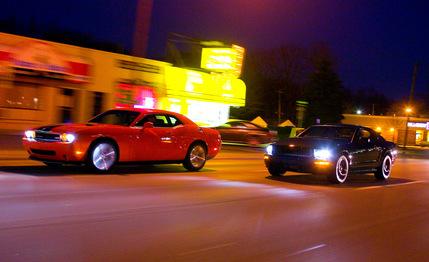
 Comparison Tests
Comparison Tests
For those who missed 1968 the first time around, not to worry: The sequel is way better.
We were there—this journal and your enduring correspondent—back when Bullitt was a movie, not a Mustang. About a year later [ C/D, November 1969], we put the original Dodge Challenger R/T Hemi through its test-track paces, too. Fun? Yeah. Gas was thirty-some cents a gallon, and our hormones were raging. That said, those were the carburetor days, and we’d never go back.
But now that Detroit is doing remakes, we’re first in line. The Dodge Challenger SRT8 is still a few weeks short of its showroom debut as we buckle into our test car. In Hemi Orange, it draws men like nickel beer, mostly guys who remember the muscle-flexing 1970–74 originals. Dodge will build mild Challengers, too, your choice of SE, standard with a 3.5-liter V-6, or the R/T, packing the 5.7 Hemi V-8, but we’ll get to those another day. Big orange is the muscled-up 6.1-liter, 425-horse Hemi. As remakes go, this one is a thriller.
Parked beside the Dodge, the dark Highland Green Mustang might as well be invisible. It draws only dust. This is the Bullitt, an evolution of the Mustang GT that includes the $3310 “Bullitt package,” limited to 7700 cars. In keeping with the covert-ops theme of the 40-year-old movie, the Bullitt package deletes the froufrou: no chrome horsie in the grille, no snakes, no fogs. You get grayed-out five-spoke mags, a shorter axle ratio (3.73 instead of 3.55), more exhaust snort, a cold-air engine intake, carbon pads on the front brakes, and a power spike of 15 horsepower, to 315 at 6000 rpm.
Oh, yeah, and the driver gets an aluminum shift ball atop the five-speed lever that he’ll grab a lot and a classy-looking engine-turned metal panel all across the dash.
The muscle-era standouts had style, but rarely did they have grace. Both of today’s re-enactors still play off four-decade-old shapes and cues. But the oldies had their unsatisfying aspects, the result of stuffing weighty V-8s into small cars that cringed from the torque and recoil. The bodies were flexy and rattly, they cornered with felony understeer, and you drove with the wheel in your chest and a roar in your ears.
On the other hand, we’d never had so much fun, and we stayed up late prowling for chicks. Or GTOs just achin’ to be whupped. Whatever kept the night going.
Yearly improvements add up to a sea change in 40 years. Horsepower is everywhere now, and cars don’t cringe from it. Moreover, there’s a whole new crop of car guys who have logged their miles in agile Hondas and turbo Subarus. So today’s question: Are these muscle-car reloads merely desperate nostalgia plays by a troubled domestic industry looking for something— anything—that works? Or are they great new choices in today’s automotive smorgasbord?
A two-man jury has been specially selected to consider this question, one of them the same guy who road-tested the Challenger 426 Hemi in 1969, the other an insightful young staffer who wasn’t born till 1978. After due deliberation, the jury finds as follows.